Generative AI is transforming the landscape of contact centers, enabling more efficient, personalized, and scalable customer interactions. As businesses seek to enhance customer experience (CX) and optimize operations, adopting generative AI in virtual agents and support teams has become a strategic necessity. However, while the benefits are vast, understanding potential risks and the future of generative AI is crucial for long-term success.
What is Generative AI?
Generative AI refers to artificial intelligence models capable of generating human-like text, images, and audio based on large datasets. These models, powered by machine learning, are trained to predict and create content that mimics human conversation, allowing contact centers to automate responses, handle inquiries, and provide intelligent support.
How Generative AI is Enhancing Contact Centers
Scalable Interactions
Generative AI empowers contact centers to manage high volumes of customer interactions without increasing human resources. AI-driven virtual agents can handle routine queries and processes, ensuring consistent support even during peak times. This scalability reduces wait times and enhances customer satisfaction.
Personalized Conversations
By analyzing customer data and previous interactions, generative AI can personalize conversations in real time. AI-driven systems can recommend products, tailor responses to specific needs, and engage customers in a way that feels more natural and human-like.
Automated Customer Interactions
From answering FAQs to processing refunds and booking appointments, generative AI automates repetitive tasks. This not only frees up human agents to focus on complex issues but also reduces operational costs and improves service efficiency.
Enhanced Multilingual Support
Generative AI models can communicate in multiple languages, breaking down language barriers and expanding global reach. This capability allows contact centers to cater to a diverse customer base without hiring multilingual staff.
Real-time Sentiment Analysis
Generative AI can assess the tone and sentiment of customer interactions in real-time, allowing agents to intervene when necessary. This enhances the overall customer experience by identifying dissatisfaction early and providing timely solutions.
Strategies to Mitigate Risks Associated with Generative AI
While generative AI offers numerous benefits, it comes with certain risks that can hinder its widespread acceptance. These risks include inaccuracies, privacy concerns, offensive content generation, and vulnerability to malicious attacks. Although these risks cannot be entirely eliminated, adopting proactive strategies can significantly reduce their impact and make AI implementation safer and more reliable.
RAG for Hallucinations and Inaccuracies
Generative AI has the potential to generate inaccurate or entirely fabricated responses, commonly referred to as hallucinations. This occurs when the AI confidently provides information that lacks factual basis, misleading customers and potentially damaging trust in the service.
One effective strategy to address hallucinations is the use of Retrieval-Augmented Generation (RAG). By integrating external knowledge bases and retrieval mechanisms, the AI can pull from accurate, up-to-date information sources rather than relying solely on its internal model
Security Measures for Privacy Concerns
Contact centers are entrusted with vast amounts of sensitive customer data, making them attractive targets for cyberattacks and data breaches. The integration of generative AI into contact center operations introduces new vulnerabilities, as AI systems can inadvertently expose personal information or become entry points for malicious actors. A breach could result in significant financial penalties, reputational damage, and loss of customer trust, making privacy and security a paramount concern for AI adoption.
To mitigate these risks, contact centers must implement comprehensive security measures. Robust encryption protocols ensure that data is protected both in transit and at rest, while stringent access controls limit who can interact with sensitive information. Aligning AI deployments with GDPR and other regulatory frameworks reinforces security measures and reassures customers that their data is being managed responsibly and securely.
Real-time Filtering Against Offensive Content
AI models, while highly capable, can sometimes generate offensive or inappropriate content that does not align with company values or acceptable communication standards. Offensive outputs—whether accidental or triggered by unusual user input—undermine customer trust and reflect poorly on the reliability of AI systems.
To address this, real-time filtering mechanisms play a vital role in detecting and blocking offensive or harmful language before it reaches customers. These filters not only scan AI-generated outputs but also block offensive or inappropriate inputs from users, ensuring that the interaction remains professional from both ends. Additionally, continuous scanning of AI outputs helps maintain professionalism and alignment with brand standards. Regular feedback loops and refinement of AI models allow organizations to retrain their systems, minimizing the likelihood of future inappropriate responses and enhancing overall reliability.
Rapid Response Protocols for Prompt Injection
Prompt injection attacks pose a significant risk to generative AI systems by manipulating inputs to elicit harmful or misleading outputs. Malicious users can craft prompts that deceive the AI into generating inappropriate or inaccurate content, compromising the quality and integrity of customer interactions.
To counteract this risk, advanced threat detection and rapid response protocols are essential for detecting and neutralizing prompt injection threats. These protocols involve continuous monitoring of AI interactions to identify suspicious patterns and trigger immediate intervention
Future Generative AI Promises
Generative AI is set to become an indispensable part of contact centers. Future advancements will enhance the collaboration between virtual agents and human teams. AI-driven virtual agents will handle initial inquiries, escalating complex issues to human agents with detailed summaries, improving efficiency and resolution times. Additionally, AI will assist human agents by suggesting responses, automating follow-ups, and providing real-time insights, leading to more productive interactions.
Conclusion
As generative AI continues to evolve, its integration into contact centers will become vital for staying competitive. By automating interactions, personalizing customer journeys, and mitigating risks, contact centers can deliver superior experiences while reducing costs. Businesses that invest in generative AI today will be better positioned to meet the demands of tomorrow’s customers.





